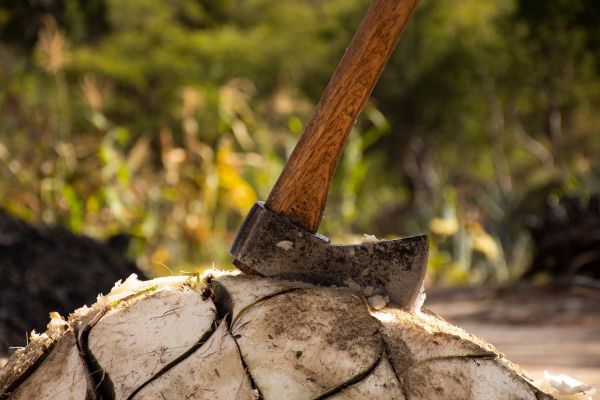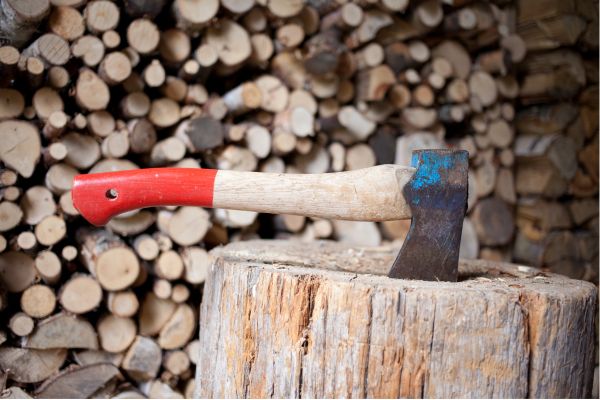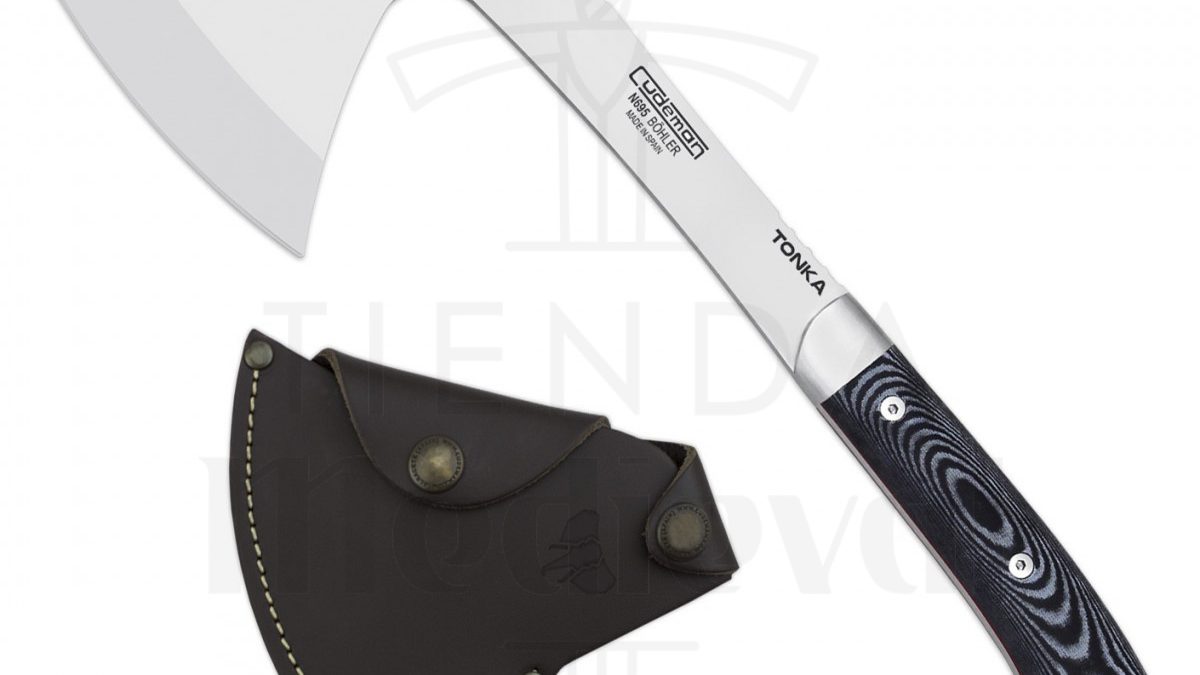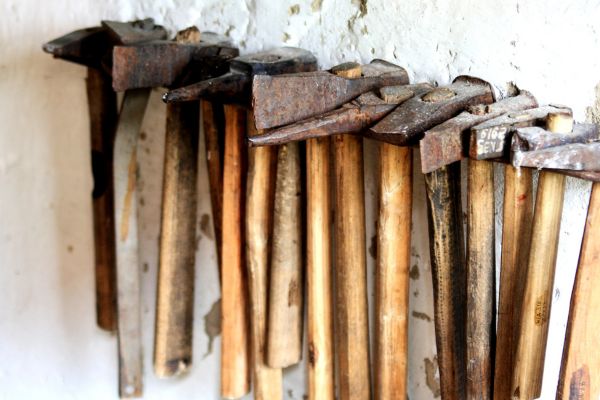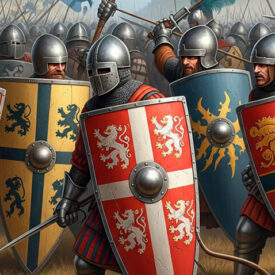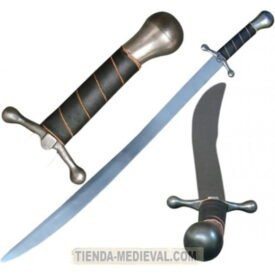Imagine for a moment a tool that has accompanied humanity through millennia, adapting, evolving, and being fundamental at every stage of our development. That tool is the axe. From the earliest civilizations to the modern era, its presence has been indispensable, serving as a key instrument for both creation and survival.
In this article, we invite you on a fascinating journey through the multifaceted history of the axe, exploring its evolution from its most rudimentary forms to today’s specialized tools. We’ll discover how it went from being a simple stone to a sophisticated tool, a fearsome weapon, and finally an essential companion for any outdoor adventure.
Primitive Origins: When a Stone Marked the Beginning
Our story begins millions of years ago. The first known form of axe was used by Homo ergaster, a hominid who lived in southern Africa between 1.9 and 1.4 million years ago. Unable to make complex tools, our earliest ancestors would sharpen sturdy stones to create a point. These “hand axes,” without a handle, were used to break branches or process food.
The great evolutionary leap came with Homo sapiens. At some point in prehistory, our ancestors discovered that by tying the stone head to a handle with cords, the force of impact increased significantly. This revolutionary design, which in essence remains the basis of the modern axe, transformed the tool, making it much more powerful and versatile thanks to the inertia of movement and gravity.
Functional axes are tools designed to accomplish a range of specific tasks. Among their most common uses are chopping down trees, preparing firewood, hunting, and self-defense. These tools are characterized by their strength and durability, as they are made with high-quality materials such as steel and hardwood.
Besides being practical tools, functional axes are also decorative items. There are models with elaborate and distinctive designs that can be displayed as collection pieces or to beautify a space.
The Metal Revolution: Stronger, Lighter, More Versatile
The advent of metallurgy marked a turning point for the axe. In Europe, during the Bronze Age (between 3200 and 600 BC), tools and weapons began to be forged in metal. This brought about amazing advantages:
- Greater Strength and Less Weight: Metal axes were remarkably stronger and lighter than their stone predecessors.
- Freedom of Shape: Metal allowed for an almost unlimited variety of designs, adapting the axe to very specific tasks.
- Mass Production: The ability to make axes from prefabricated molds facilitated large-scale production.
With metal, axes were perfectly matched with handles of ideal size for each purpose and quickly became one of the main weapons of close combat for peoples such as the Celts.
The Viking and Medieval Era: The Axe as a Fearsome Weapon on the Battlefield
The Middle Ages were a period of incessant conflict, and in this context, axes achieved great prominence as weapons of war. While today we consider it a tool, for centuries it was a formidable instrument of combat.
The felling axe is the most common type of axe and is used for cutting down trees and branches. Its blade is long and straight, and its handle is typically made of wood or fiberglass.
Few peoples are as synonymous with the axe as the Vikings. For them, it was much more than a simple tool or weapon; it was deeply rooted in their culture and society. They developed long-handled axes with sharp blades that could pierce chainmail and breastplates with ease. Their combat techniques included quick attacks, parries, and counterattacks, using both the edge and the blunt sides.
Axes were also thrown as a surprise element at the start of battles. The curved shape of some heads even made it possible to hook the ankles of enemies to bring them down.
Symbol of Power and Status
In Viking society, a well-made or decorated axe was a symbol of power and social status, sometimes used as a gift or token of recognition. They also had ritual and spiritual significance, being used in ceremonies or even buried with their owners.
Manufacture and Trade
The forging of Viking axes was a refined art. Blacksmiths used complex techniques, folding iron and incorporating steel to create strong, sharp blades. These axes were not only used in Scandinavia but were traded throughout Europe, influencing the design and practices of other cultures.
During this time, axes were mainly used by infantry soldiers, as they were more accessible than the costly armor and swords of knights. Curiously, they were sometimes used for non-lethal blows, aiming to humiliate an opponent considered inferior.
The 19th and 20th Centuries: From Weapon of War to Everyday Tool
With the evolution of firearms, the preeminence of the axe in the military sphere gradually began to decline. From the 19th century onwards, its primary function was redefined, becoming an essential tool for civilian life and work. It became the inseparable companion of loggers and farmers. Later, in the 20th century, its strength and functionality made it indispensable for firefighters and rescuers, who use it to break through obstacles in emergency situations.
The splitting axe has a wider blade and a shorter handle than the felling axe. It is mainly used for splitting firewood and chopping wood.
The Axe Today: A Versatile Tool for Outdoor Enthusiasts
Today, the axe has regained its luster—not as a widespread weapon of war, but as an indispensable tool for the outdoors. Its compact size and light weight make it ideal to carry in a backpack or on the belt.
The tactical axe is lighter and more compact, designed for use in survival situations and personal defense. They often include additional features such as a hammer or pick.
A modern axe is characterized by its lightweight design and a shorter handle than a traditional axe, allowing for single-handed use and offering precision and control. Many models even feature a hammer head on the opposite side of the blade, adding even more versatility.
Its common uses cover a wide range of activities:
- Wood Processing: Chopping branches and small logs, splitting firewood, and limbing.
- Carving and Construction: Building shelters, crafting tools, and artistic projects.
- Hunting and Survival: Processing game, building traps, and as an emergency tool.
The hunting axe has a narrower and sharper blade, designed for skinning and dismembering animals. Its handle is shorter and ergonomic.
The advantages of carrying an axe are clear: portability, versatility, ease of use, and efficiency. Although it cannot completely replace a full-sized axe for larger felling tasks, it is a lightweight and highly effective alternative for camping and survival situations.
Maintenance remains crucial for the durability of the axe, just as it was in the Middle Ages. Cleaning the blade to avoid rust, sharpening it regularly, and caring for the handle are practices that extend its useful life. Safety, of course, is paramount; maintaining a firm grip and planning your movements has always been key to using it effectively and avoiding accidents.
As for size and weight, it is important to select an axe that is comfortable to handle and allows you to perform the desired tasks without difficulty. The material of the handle and blade are also fundamental, as they determine the durability and strength of the tool. Wooden handles are more traditional, but fiberglass and reinforced plastic ones are also viable options. As for the blade, carbon steel is the most commonly used material, as it offers a good compromise between strength and durability.
The blade type is also a key factor when choosing a functional axe. Depending on its intended use, you may need a wider, more curved blade for splitting firewood or a narrower, sharper blade for skinning animals.
Proper maintenance of a functional axe is crucial to ensure its durability and efficiency. Among the most important aspects of caring for an axe are cleaning, sharpening, and handle maintenance.
It is essential to clean the axe after each use, removing any dirt or residue that may accumulate on the blade or handle. In addition, the blade should be sharpened regularly to keep it in optimal condition and ensure it performs well for the intended tasks. Finally, the handle should be inspected and treated periodically to prevent deterioration and ensure a safe and comfortable grip.
Functional axes are versatile and valuable tools that have been used by humanity throughout history. Knowing the different types of functional axes, how to choose the most suitable one for our needs, and their proper maintenance will help us make the most of them and enjoy their effectiveness in our daily activities. Whether it’s for chopping trees, preparing firewood, hunting, or self-defense, a functional axe is an indispensable tool in any home or survival kit.
Types of Functional Axes and Their Characteristics
Throughout history and today, axes have evolved in design and functionality, adapting to the needs of each era and culture. Below is a list of the most popular types of functional axes:
- Felling axe: This is the most common type of axe and is used to cut down trees and branches. Its blade is long and straight, and its handle is usually made of wood or fiberglass.
- Splitting axe: This type of axe has a wider blade and a shorter handle than the felling axe. It is mainly used for splitting firewood and chopping wood.
- Hunting axe: These axes have a narrower and sharper blade, designed for skinning and dismembering animals. Its handle is shorter and ergonomic.
- Tactical axe: This type of axe is lighter and more compact, designed for use in survival situations and personal defense. They often include additional features such as a hammer or pick.
- Ceremonial axe: These axes are more decorative than functional and are used in ceremonies and cultural events. Their design is more elaborate and ornate.
As technology and materials have advanced, functional axes have seen improvements in their designs and features. For example, today there are axes with ergonomic handles that provide a better grip and reduce fatigue during use, as well as axes with blades coated with materials that minimize friction and prevent corrosion.
Additionally, axes have gone from being exclusively manual tools to now including electric or motorized models in certain cases, such as chainsaws and electric log splitters, which offer greater efficiency and speed in wood cutting and processing tasks.
Likewise, functional axes have been adapted to different contexts and specialized uses, such as the ice axe used in mountaineering, which features a specific design to facilitate climbing on ice and snow.
Functional axes have undergone constant evolution throughout history, adapting to the needs and technological advancements of each era. This has allowed them to remain indispensable tools today, both in professional fields and in survival situations and outdoor activities. To find the perfect model for you, we invite you to explore our wide selection of functional axes at Medieval Shop, where history and functionality come together to offer you tools of the highest quality.

